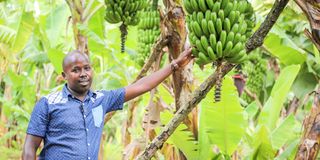How I began farm with Sh5,000

Nelson Chirchir on his banana farm in Kericho County where he farms the crop full time.
What you need to know:
- Chirchir, the chairman of Sigowet Community Demand Driven Committee, a farming group, says he went for bananas as a business because the crop does not require much capital.
- The full-time farmer has staggered his crops to ensure they mature at different times so that he earns throughout the year.
- His long-term goal is to add value to the bananas by ripening and making crisps.
- Tissue culture bananas are tolerant to diseases and drought, ensuring farmers earn more.
Nelson Chirchir considers himself a non-conformer, which is why he does not grow tea in an area where the crop is dominant.
On a third of his two-acre family farm in Sigowet sub-location, Kericho County, he cultivates four varieties of bananas namely Giant Cavendish, Uganda Green, Ng’ombe and Sweet.
“Of all the bananas, I love the Giant Cavendish because it has very big fingers. Its bunches are also very big, compared to other varieties and it fetches good money in the market,” he says, noting the variety occupies half of the land on which he grows bananas.
He has 44 plants of the variety, 40 Uganda Green, eight sweet bananas and Ng’ombe is the latest addition, of which he has 10 .
“I am growing Ng’ombe on a pilot basis because I want to increase the number of plants after seeing their performance,” says the 32-year-old, adding he grows sweet bananas for domestic consumption.
Mature at different times
Chirchir, the chairman of Sigowet Community Demand Driven Committee, a farming group, says he went for bananas as a business because the crop does not require much capital.
“My start-up capital was Sh5,000. I paid workers to dig planting holes at Sh50 each after sourcing the planting materials from other farmers. I started farming to keep myself busy soon after graduation in 2017 but now it is a business," says Chirchir, a Community Resource Management and Extension graduate from Kenyatta University.
The full-time farmer has staggered his crops to ensure they mature at different times so that he earns throughout the year.
“For optimum yields, I apply one ‘debe’ of farmyard manure per plant every month. I also use 250g of NPK 2323 fertiliser per stool, which is preferred for the bananas,” says Chirchir.
He sells a bunch of green bananas at Sh500 and ripens others for sale at Sh10 each.
Ready for harvesting
After ripening, Giant Cavendish can take up to two weeks before going bad, unlike the Uganda Green, which takes two to three days, notes the farmer.
From a seedling, the Cavendish takes about 18 months to be ready for harvesting.
Dr Nasambu Okoko, a senior research scientist at the Kenya Agricultural and Livestock Research Organisation (Kalro) Food and Crops Research Institute in Kisii, says the banana is one of the most important food crops that do not have an organised seed system.
“But we are developing improved varieties that are climate-smart and yield highly,” says Okoko. “The aim is to ensure farmers plant clean materials.”
Chirchir and tens of other farmers receive training on banana production, value addition and new varieties from the Kenya Climate-Smart Agriculture Project (KCSAP), run by the government through Kalro and other partners.
Clean planting materials
The training has helped him fight diseases like cigar-end rot, which affects bananas. The disease is caused by the fungus Trachysphaera fructigena and spreads to the tip of the fruits, causing a scorch-like rot that resembles cigar ash.
“One must prune the bananas to enhance air circulation. Dampness around the fingers provides conditions that are conducive for fungi to thrive, causing cigar-end rot,” offers Chirchir.
His long-term goal is to add value to the bananas by ripening and making crisps.
“I also plan to do commercial seedling production using macro-propagation as a means of producing clean planting materials.”
Dr Okoko says tissue culture bananas are tolerant to diseases and drought, ensuring farmers earn more.
"Even under extreme climate changes, they are able to grow and the farmer will be able to get some harvest.”




